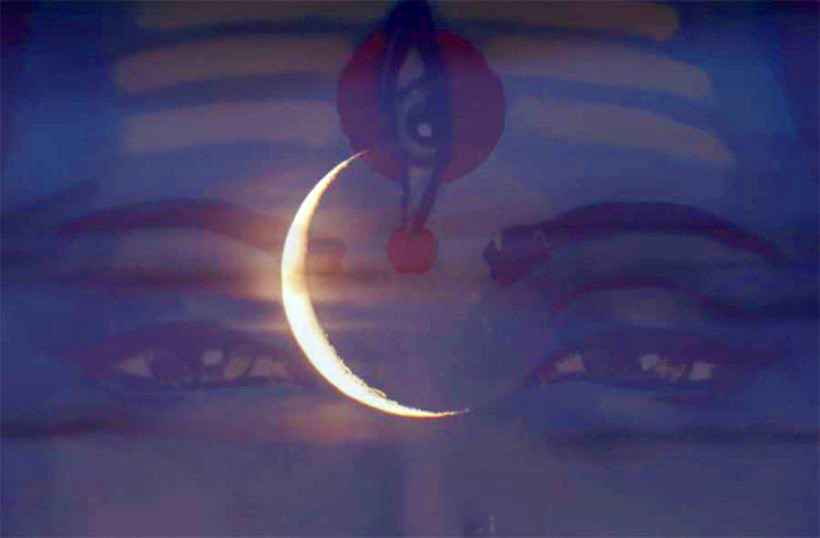
by Somya Devi | Feb 28, 2019 | Astrology, Conjunctions, Holy Days, Planets Changing Signs, Retrograde
The Moon wanes in sidereal Aquarius on the dark night of March 5th, approaching the exact Sun-Moon alignment for a New Moon at 8:04 am on Wednesday, March 6th, beginning a new lunar cycle. Leading up to this will be Maha Shivaratri, “the great night of Lord Shiva,” on March 4th. This is an auspicious night for prayer and penance, and the benefits of sadhana are multiplied by the Moon’s position and the collective vibration.
Maha Shivaratri
Monday night, March 4th, the night prior to the Dark Moon night, is the fourteenth waning phase of the lunar cycle. During this month this night is celebrated as Maha Shivaratri. This is perhaps the most auspicious night of the year for doing sadhana (spiritual practice). It is traditional on this night to stay up all night fasting, chanting, praying, and meditating. This holiday honors Lord Shiva, the great ascetic, and we can recall two stories of great sacrifices that he made protect the entire creation.
One of these is the story of the churning of the milk ocean, which the gods and demons were doing in order to release the nectar of immortality. Before the nectar came up, however, a poison came up first. (This is similar to when we do spiritual practice and begin our path of self-inquiry, and negative tendencies often come to light first, which can be a painful experience. Similarly, during a physical fast or cleanse, toxins can be shaken loose and released first, causing a healing crisis before we continue healing into a freer, happier state of being.) When the poison came up from the milk ocean, Lord Shiva consumed it so that it would not engulf humanity, as a great and noble sacrifice. His wife, Parvati, however, held his throat so that he could not ingest it, thus saving him from being harmed by the poison.
Maha Shivaratri also commemorates the wedding of Shiva and Parvati, which also stemmed from great sacrifice made for the benefit of all humanity. It was said that after his first wife, Sati, perished, Shiva was fully devoted only to his sadhana, meditating for aeons in isolation and renouncing the world. Then the demon Tarakasura began running amock on earth, threatening all of humanity. Brahma foretold that only Shiva’s child could defeat Tarakasura, so the gods devised a plan for Sati to reincarnate as Parvati, and win over her Lord to marriage once again. He was not easily swayed, however, and it was only after Parvati became an ascetic and underwent great penance that he agreed to marry. They eventually produced their son Kartikkeya, who went on to slay the demon.
Thus, this holiday is celebrated through the penance of fasting, forgoing food, water, and sleep, for one night, and simultaneously celebrating the union of Lord Shiva and Parvati, or the masculine and feminine energies of creation, that allows this dance of life to continue. It is an apt time to feel the forces of Aquarius upon us, which compel us to consider our role in society, and in the universe, and what personal sacrifices we can make for the greater good. Even if you’re not able to stay up the whole night, any amount of devotional practice, serviceful sacrifice, or chanting of Om Namah Shivaya on this night can have beneficial affects that are magnified greater than on any other night.
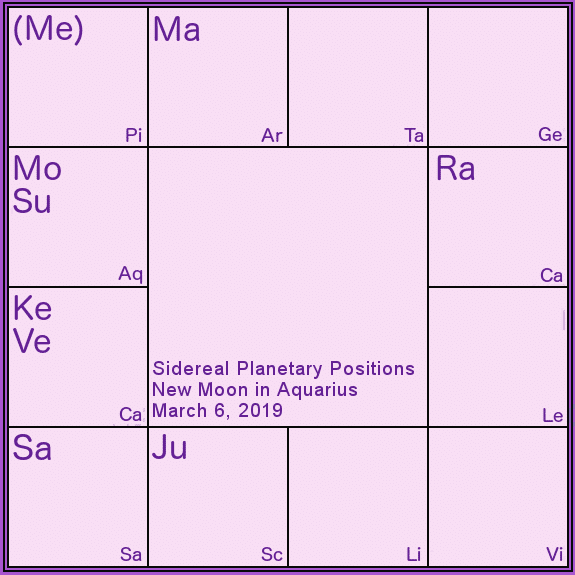
Aquarius Moon Cycle
The Sun and Moon meet in sidereal Aquarius to begin this lunar cycle. Aquarius is known as Kumbha in Sanskrit, a word for “pitcher” or “vessel.” According to the Vedic texts, the sign Kumbha can be imagined as a man holding a pot, with deep-brown skin, standing in the water. We can see this Aquarian imagery in the sadhus of India (and its biggest ritual pilgrimage day, the Kumbha Mela), who make their lives an offering of service to society through their prayers and Saturnian austerities, while renouncing the individual self. In the Aquarius cycle, we think about how we can serve the whole.
Saturn both rules Aquarius and is aspecting the Sun and Moon here (from sidereal Sagittarius) at the time of this New Moon. Saturn brings to us awareness of the long term and the bigger picture, and through this masculine or active sign, compels us to make commitments and offerings to something greater than ourselves and our momentary happiness. This is a great month to consider a new way that you may be of service to your community or to society.
Purva Bhadrapada
The New Moon cycle begins with the Sun and Moon in the Vedic nakshatra called Purva Bhadrapada, the former “lucky footed one.” This nakshatra bridges Aquarius and Pisces and is often represented by a funeral cot, symbolizing the transition from life into death, or ultimate liberation. It is ruled by Aja Epakada, the one-footed goat who is often associated with the image of Lord Shiva as Nataraj dancing on one foot, a fitting image for Maha Shivaratri.
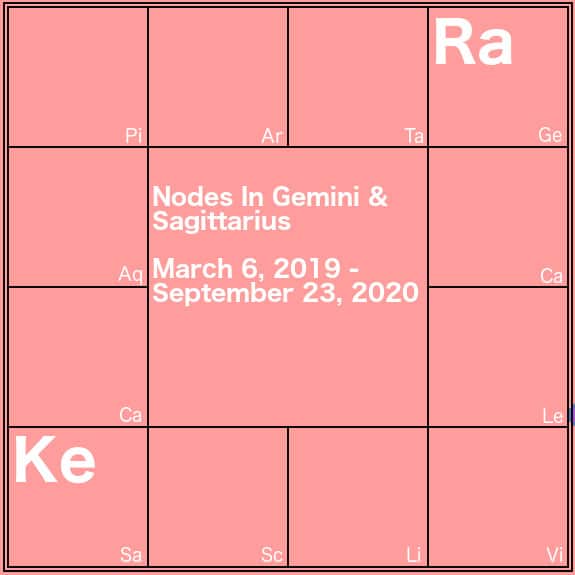 Nodes Are Changing Signs!
Nodes Are Changing Signs!
With a mean node calculation, Rahu and Ketu will transit into Gemini-Sagittarius on March 6th. (Under a true node calculation, they will not change signs until March 23rd; See Technicalities: Mean vs. True Node section below if you want a little more info about nodal calculations.) Regardless of the calculation used, March is a month of transition for the nodal energy. With the nodes in Cancer-Capricorn for the last year-and-a-half, we collectively felt a dichotomy between listening to the heart and following our emotions, against doing what is practical and responsible in an earthly way. It was a chance to balance these two things as well, learning to create a harmony between the practical and the emotional.
Throughout the coming transit of Rahu and Ketu through Gemini and Sagittarius, we will be feeling a polarization between curiosity, fact-finding and learning in an intellectual way, versus taking actions based on our principles and beliefs. Sometimes the intellectual mind does not agree with our fiery passions. This transit will be a time to learn to balance the two. With opinionated Sagittarius on one side, and communicative yet flexible Gemini on the other side, we may learn new ways to communicate and interact with those who oppose us in ideas, stepping into another’s shoes while still maintaining and honoring our personal beliefs and philosophy.
For each natal rising sign, this coming transit will affect a particular axis of learning in your life. You will be more able to see and work with some of your blind spots in these areas throughout the coming year-and-a-half long nodal transit. These things will especially surface around the bi-annual pairs of eclipses (coming this year in July and December).
Mercury Retrograde
Mercury stations and begins apparent retrograde motion on March 5th, the day before the New Moon. He is also currently debilitated in sidereal Pisces, so this time period could have us a bit mixed up around some details, and possibly challenged with communication and accuracy. He’ll retrograde back into Aquarius on March 14th, before returning to direct motion on the 28th.
Jupiter Gandanta
Also during the first half of this lunar cycle, Jupiter will enter the last 48 minutes of sidereal Scorpio (one muhurta), on March 15th. This region of the sky, called gandanta or a “knot,” is considered one of the most difficult places in the zodiac. It spans for one muhurta before and after the 0° point between sidereal Scorpio and Sagittarius, as well as those regions on the cusp of Cancer-Leo and Pisces-Aries (however, this gandanta location is often considered the most difficult. (Some astrologers may consider it spanning up to one or even two or three degrees to either side of the cusps.)
Normally, a planet transits through this zone rather quickly. Jupiter is currently slowing down, however, and will come to a stationary halt at 0°14’ of sidereal Sagittarius on April 10th, before beginning retrograde motion and passing back into Scorpio. He will threrefore be traveling the gandanta zone all the way from March 15th until May 6th (or longer if the zone is interpreted as wider).
Though Jupiter will be dipping into his own sign from March 15th through April 22nd, the fact that he will remain in gandanta at this time will not bring the added strength that we would expect from a sva graha. Those who are ruled by Jupiter may feel a bit “stuck” in various ways throughout this transit. It is important to be patient and keep up with sadhana during this time. Additionally, he will be joined by both Saturn and Ketu during his time in Sagittarius, both of which can be challenging companions.
Technicalities: Mean vs. True Node
Rahu and Ketu have been transiting through the Cancer-Capricorn axis for nearly 18 months, and are getting ready to make their transition into the Gemini-Sagittarius axis, for the next 18. The date of this transition will vary whether you are using the “mean node” calculation or the “true node” calculation. To simplify this as much as possible, we must realize that the nodes do not have planetary bodies that can be observed as the other grahas can be. (The grahas are “the forces that grab us,” including the Sun, Moon, Mars, Mercury, Jupiter, Venus, Saturn, Rahu and Ketu.)
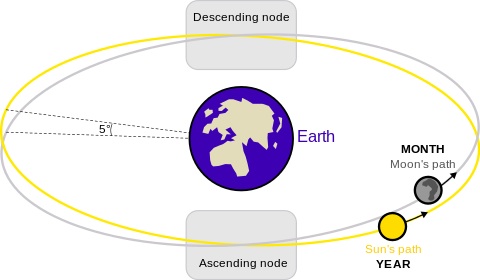 The nodes, astronomically are the places where the Sun’s and Moon’s paths intersect. The ecliptic is the apparent paths that the Sun travels “around” the Earth. The Moon’s orbits is not completely flat or parallel with the Sun’s, but slightly inclined, so that it passes this line and is sometimes to the north of it, sometimes to the south. We can measure astronomically and by observation when these crossings happen. To get the mean node, we take an average distance between these two points based on how many days it takes the Moon to get from one to the other. The true node is calculated using a method that also accounts for the slight wobble of the earth and the Moon’s orbit around it.
The nodes, astronomically are the places where the Sun’s and Moon’s paths intersect. The ecliptic is the apparent paths that the Sun travels “around” the Earth. The Moon’s orbits is not completely flat or parallel with the Sun’s, but slightly inclined, so that it passes this line and is sometimes to the north of it, sometimes to the south. We can measure astronomically and by observation when these crossings happen. To get the mean node, we take an average distance between these two points based on how many days it takes the Moon to get from one to the other. The true node is calculated using a method that also accounts for the slight wobble of the earth and the Moon’s orbit around it.
Some astrologers favor using the “mean” node calculation while others prefer the “true.” These two calculations of the node will sometimes put them about one degree apart, which is noticeable in cases where, in a natal chart, someone’s node is on the cusp of two signs (it may be in one sign using mean node and another sign using true node). It also affects the date of transition between signs that we observe when talking about nodal transits. In both cases, it is best to observe for yourself (use a lot of charts for case studies) and see which makes the most sense to you. I prefer using mean node calculation.
Personal Readings are available to help you understand your individual natal chart and how these transits will affect your upcoming year.

by Somya Devi | Feb 3, 2019 | Uncategorized
The Sun and Moon are coming together again for a dark Moon (the amavasya lunar phase) tonight, February 3rd. They will come into complete alignment for a “New Moon” at 21° sidereal Capricorn tomorrow, February 4th at 1:04 pm PST to begin a new lunar cycle. Now is a good time to go inward, taking a break from too much activity, and let go of some of the past month’s energy as we prepare for the new. The Sun and Moon meet in the Vedic nakshatra of Sravana, the star of hearing.
Capricorn
This new lunar cycle will begin under the energy of Capricorn, with Sun and Moon joining both Mercury and Ketu there. Capricorn is the feminine earth sign ruled by Saturn, the disciplinarian. Under Capricorn energy we look at ourselves and see where we need to be more responsible and committed, where our lives are calling for more structure and hard work. Saturn can give perseverance, so wherever you set your sights and goals now will have support in the coming month.
Yet at the same time, we may see that the benefit comes from reducing activities and keeping order and routine. We may find ourselves putting more things in order in our physical worlds, and also paying attention to our general level of groundedness. Near the end of winter, and after the usual business of the holidays, it is a really good time to allow for more stillness in your life, before the energy of spring comes on and calls us outward again.
Because of Ketu’s conjunction here, we may feel some residual “eclipse energy,” which helps to show us blind spots and blockages. We have experienced this energy along the Cancer-Capricorn axis for nearly a year-and-a-half now, as Rahu and Ketu have transited there, and this month may be a final phase of integrating those lessons in our lives before the nodes move into Gemini and Sagittarius.
Sravana
Within the Vedic zodiac, this New Moon aligns with Sravana nakshatra, the star-sign of hearing, listening, and learning. This promotes a great energy for acquiring knowledge, both inner and outer. As we turn inward and listen with the inner ear (through meditation and other mindful practices), great wisdom can be revealed. This nakshatra is also associated with learning from oral traditions, and supports communication in general. As Mercury joins Ketu during this New Moon, we have a chance to release some blockages around communication, or reveal some ancient or inner wisdom, but be very alert with this as the nodes can also be quite unpredictable.
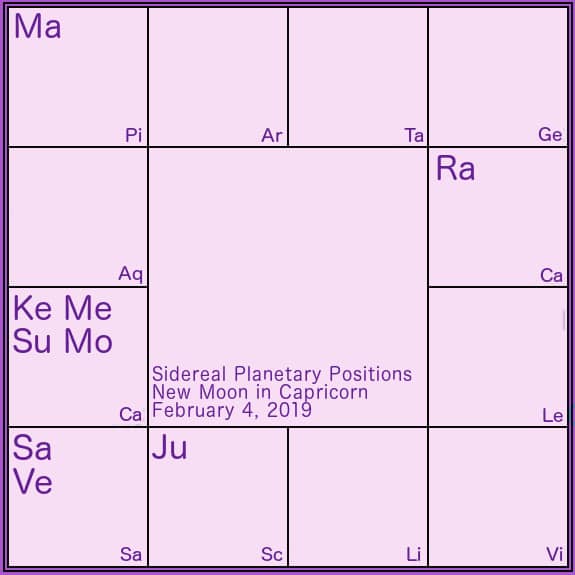
Venus & Saturn
Venus and Saturn are now joining in Sagittarius for a few weeks, until the 21st. Their energies can complement each other as Venus reminds the disciplined Saturn that we need to enjoy life as humans, while Saturn reminds Venus to use some discernment and not over-indulge in sensory pleasures. They will come within one degree of each other, as Venus passes Saturn, from February 17th-18th, causing a graha yuddha or planetary war. During this time, the things ruled by both planets can suffer (per your individual chart), and in general we may feel a great inner struggle, as our natural inclinations for pleasure seem in great conflict with our long-term goals and commitments. Commitment in relationships in particular could feel stressed during these days.
Mars
Mars and Jupiter have been exchanging signs, with Mars in Pisces and Jupiter in Scorpio, creating a certain harmony between the two for several weeks. Mars will move into Aries on the 5th of February, coming into full strength in his own sign and Moolatrikona position as he transits 0° to 12° Aries. This time could be beneficial for Mars-ruled people especially. Everyone has Mars ruling something in their charts as well, and these areas may have gone through a great deal of difficultly last year during the 6-month Mars-Ketu conjunction in Capricorn. The coming transit will be a time to harness strength again in these areas.
If you missed it, be sure to check out the 2019 Jyotish Transit Summit from last month! Myself and four other astrologers go over all the major planetary movements and what to expect for the coming year!
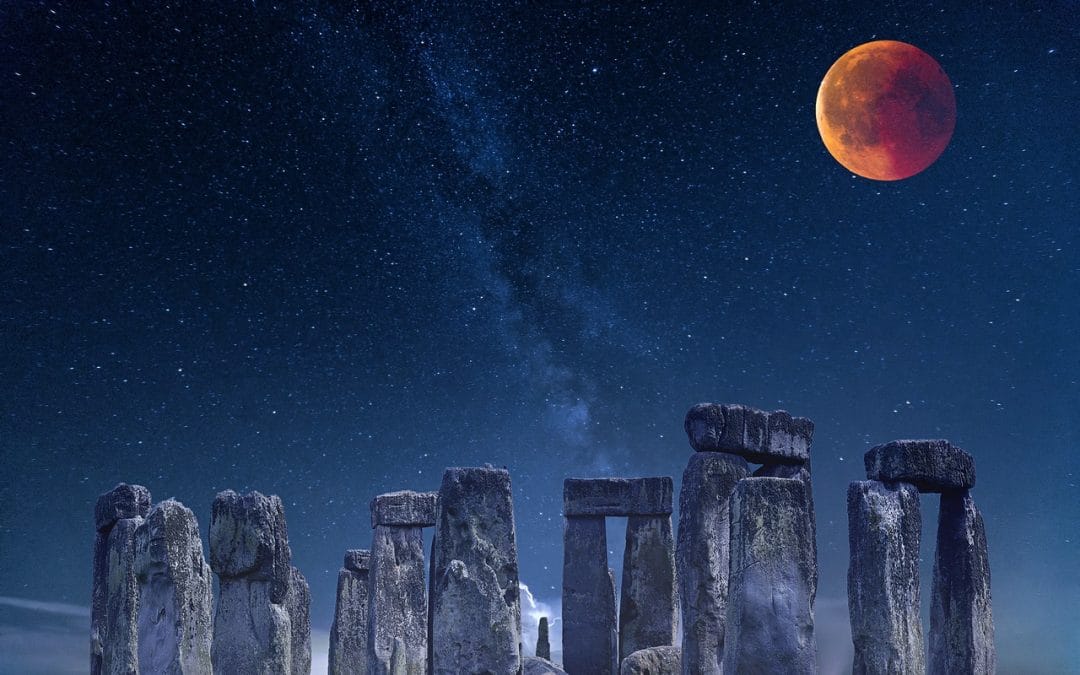
by Somya Devi | Jan 17, 2019 | Astrology, Conjunctions, Eclipses, Planets Changing Signs
This Sunday night brings a full Moon lunar eclipse in Cancer. This eclipse will be visible from all of north and south America, and at least partially visible from Africa, Europe, and the Middle East. The shadow will create a red hue over the Moon, hence “blood Moon.” The Full Moon peaks at 9:16 pm PST on January 20th, while the maximum eclipse is at 9:12 (with the full eclipse from 8:42 until 9:43 pm). The partial eclipse begins at 7:33 pm and ends at 11:48, west coast time.
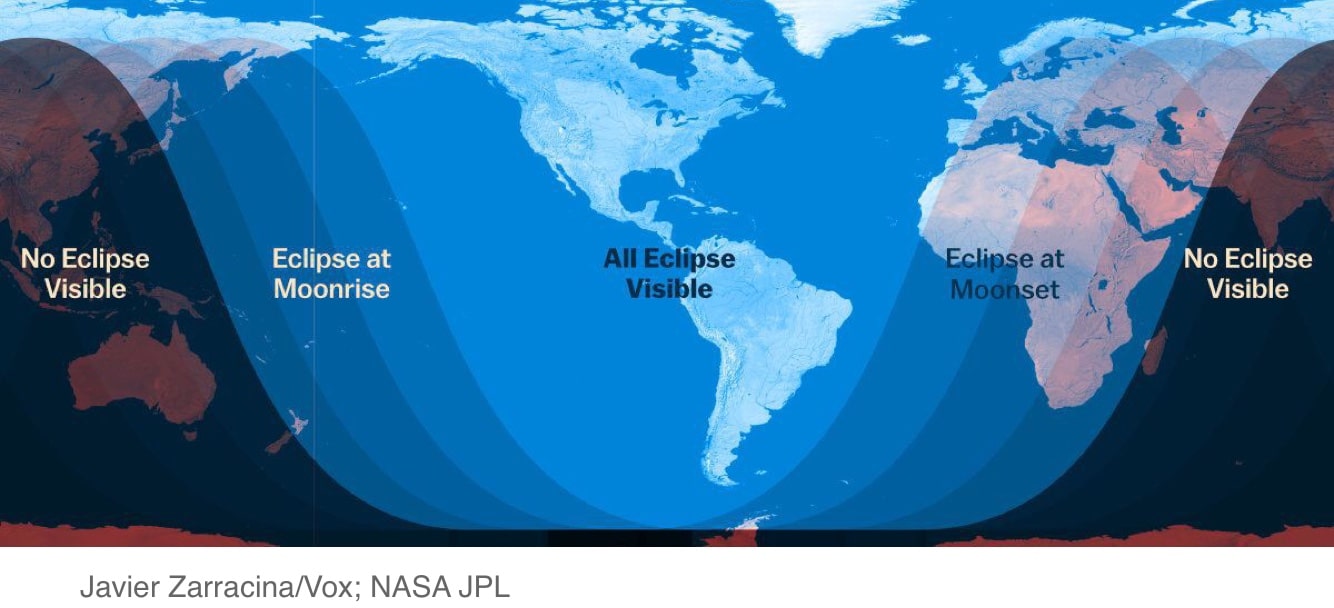
Eclipse in Cancer
This is the last of a series of eclipses with the nodes, Rahu in Ketu, in sidereal Cancer & Capricorn respectively, beginning with the total solar eclipse over North America on August 21, 2017. That eclipse was a transitional one, occurring just as the nodes were moving from the Leo-Aquarius axis onto the Cancer-Capricorn one.
With Rahu in Cancer and Ketu in Capricorn, we have collectively been exploring the dichotomy between emotionality and practicality. Cancer is the sign of the heart, the mother, the divine feminine, and the flow of emotional and literal waters. Capricorn, on the other side, is a sign of practicality, where we stand grounded in earthly responsibility. Throughout this transit we have been called to examine how to balance these two poles, considering when to let the heart run free and follow the flow of our feelings, and when to stay committed to difficult work that may sometimes feel overly structured.
In some areas of life we have seen where we needed more commitment, more structure, and to develop a certain amount of detachment from the emotions, which may have felt exaggerated, intense, or irrational at times during this transit (especially near other eclipses). In other areas, or for other folks, we have observed a need to open the heart more, and let loose on the reins of practicality while allowing the senses guide us more. Overall, it is about learning to blend and harmonize these two seemingly opposites, weaving the right amount of humanity with the work that it takes to be human.
The particular effect of this transit and of these eclipses is (and has been) felt specifically in the areas of life indicated by the houses in your individual chart that fall across Cancer and Capricorn. (Last chance to grab your Free Rahu-Ketu in Cancer-Capricorn Forecast, downloadable bonus for joining my free email list!) Whether it was work vs. home (Aries & Libra), self vs. other (Cancer & Capricorn), or another dichotomy, the nodal transit and eclipses here showed us our blind spots in a particular area of life, and encouraged us to clear out the cobwebs to create more harmony and clarity.
Though eclipses can be revelatory with proper discipline, practice, and self-inquiry, on a mundane level they often throw us off-balance and disrupt the area of life being affected (Cancer and its associated house in your chart this weekend). When the Moon is full the emotions are strong, the mind is active, and the heart is alive, but during the lunar eclipse the shadow energy of Rahu will obscure some of our mental and emotional focus. We can feel confused about the emotions that are arising, or may even lose focus or find it difficult to access the heart. You may feel like you’re “not yourself” during the eclipse.
It’s best to be patient, grounded, and do some type of spiritual practice during and around the eclipse window. If unusual sensations do arise, take mental note or even write them down, and be sure to reflect further on what was revealed after the eclipse has passed. In Indian tradition, it is advised to stay indoors and not eat or drink during an eclipse, so as not to absorb negative energy from the atmosphere.
Pushya
The Full Moon aligns with Pushya nakshatra, “the nourisher,” within Cancer. Represented by a cow’s udder, this part of the sky brings the potential to nourish others as well as to nourish ourselves from within. With the eclipse here, beware of a sensation of mal-nourishment or loss of vitality, especially if you have your Moon or another planet here. The deity Brihaspati (a form of Jupiter) rules here, as well as the planet Saturn, so consider making offerings to them on this eclipse.
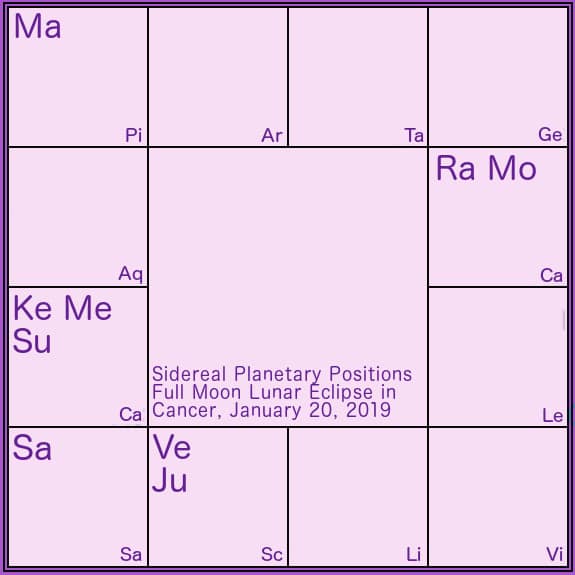
Venus-Jupiter War
Just hours after the eclipse, Venus will come within one degree of Jupiter, causing a planetary war (graha yuddha) that will last until the 23rd of January. The two planets will be visible in close conjunction in sidereal Scorpio in the early morning, so close that they are understood to be competing for our energy and attention. The things ruled by both planets can suffer during this time — relationships, pleasures, and happiness for Venus, and our idealism and optimism for Jupiter. In particular, both planets rule two areas of your individual chart, so all four areas may also experience difficulty or seem to conflict with each other during the war.
Mercury-Ketu Exact
On the 21st, Mercury and Ketu will come into exact conjunction in sidereal Capricorn. People who are ruled by Mercury (Vedic ascendants Gemini or Virgo) should take special care this week, especially of the physical body. For the general populous, the south node joining the planet of the intellect can enhance psychic awareness, but disturbances of the psyche are also possible. Mercury will be quite close to Ketu during the eclipse, and these effects could be magnified.
Please join me and my fellow astrologers on January 25th for a 2019 Jyotish Transit Summit Webinar. We will discuss all of the major planetary transits for 2019. The webinar is free, and you can register through this link.
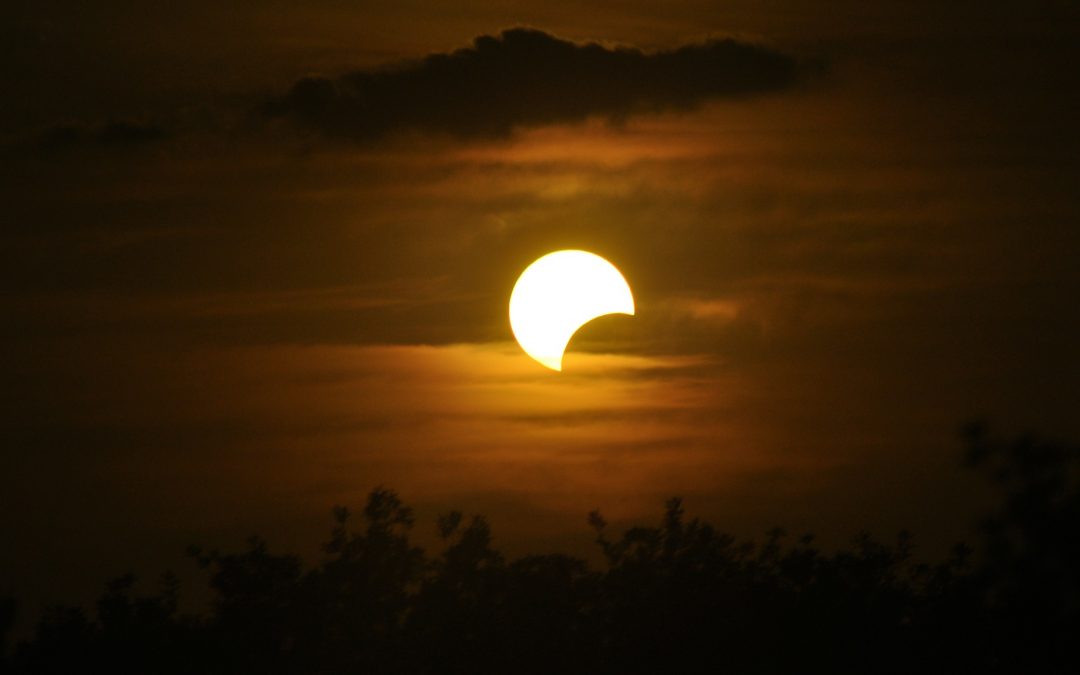
by Somya Devi | Jan 3, 2019 | Astrology, Conjunctions, Eclipses
The Moon is waning towards total darkness and will reach exact conjunction with the Sun for the “New Moon” moment on Saturday, January 5th, 2019, at 5:28 pm PST. The Sun and Moon will join at 21° sidereal Sagittarius, aligned closely with the center of the Milky Way galaxy, in Purva Ashada nakshatra. The Sun and Moon will be in close enough proximity with Ketu (at 3° sidereal Capricorn), to bring about the first eclipse of the year. The partial solar eclipse will occur over eastern Asia and the Pacific, reaching its maximum at 5:41 pm PST, and visible from eastern China, Mongolia, and Russia, as well as Japan, the Korean peninsula, and southwestern Alaska.
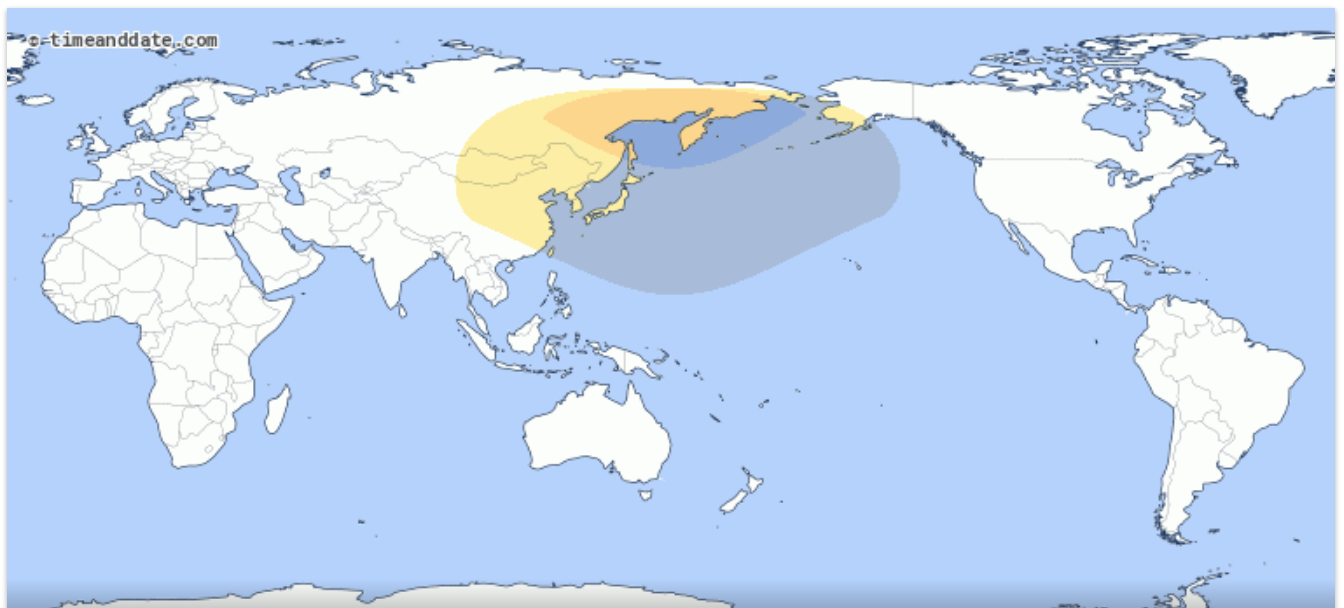
Sagittarius
This new Moon solar eclipse will occur in sidereal Sagittarius, setting the tone for the coming month with a Sagittarian mood. Sagittarius is an active fire sign ruled by Jupiter, the planet of principles and beliefs. This new Moon will bring forward a healthy dose of principles and opinions, but with the Sun partially blocked by the Moon’s shadow, we may feel overly emotional about these and at the same time, lacking the power to do anything. (You can also relate that sentiment with the area of life mentioned in the Forecast section below). Within Purva Ashada nakshatra, however, we may find more courage from within than seems readily at hand.
Purva Ashada
This nakshatra spans from 13°20′ to 26°40’ of sidereal Sagittarius, and means the former “invincible” or “unconquered.” It is ruled by Apah (or Apas), the water goddess. Its animal symbol is the male monkey, which brings a playful energy here. Its planetary ruler is Venus and thus also has associations with goddess Lakshmi. The three stars that make up this nakshatra in the night sky take the shape of a fan, and the fan is another symbol for this asterism.
Under its invincible nature, the Purva Ashada new moon is a powerful time to find our courage, despite the feelings of limitation that can be brought on by a solar eclipse. Through the symbol of the fan, we can see one who is adorned in luxury, or one who may hide behind a fan in humility or mystery, but there is a great power that can be hiding there, especially feminine power. The fan can be used to sustain us under pressure, bringing a cooling breeze that feels like the grace of god when the world gets too hot. Though our power may feel hidden, it is there to be tapped into with focus and dedication.
Saturn and Mercury
Saturn and Mercury both join this new Moon in Sagittarius. Saturn is going to have an even stronger role in our lives than usual in 2019, as he will be joining Ketu in close conjunction, within one degree, for over five months. Saturn in Sagittarius can help us to have not only the courage to do what we believe is right, but the stamina and dedication to get it done. Though we may feel a bit muddled by the eclipse (and the current combust nature of Saturn, so close to the Sun), Saturn’s determination will reveal himself more as the month goes on.
There will be a planetary war, however, between Saturn and Mercury, on the 12th and 13th of this month, when the two come within one degree of each other. When two planets are at war, contending for our attention in the same part of the sky, both will suffer, and the things they represent. With Mercury at war, our intellects will not feel as sharp, and it may be hard to pay attention to details or communicate clearly on these days. With Saturn at war, keeping our eye on long-term goals may be hard, and we may feel temporarily deflated and struggle at work. The four areas in your chart ruled by Saturn and Mercury may also suffer, or feel at odds with each other, during this time.
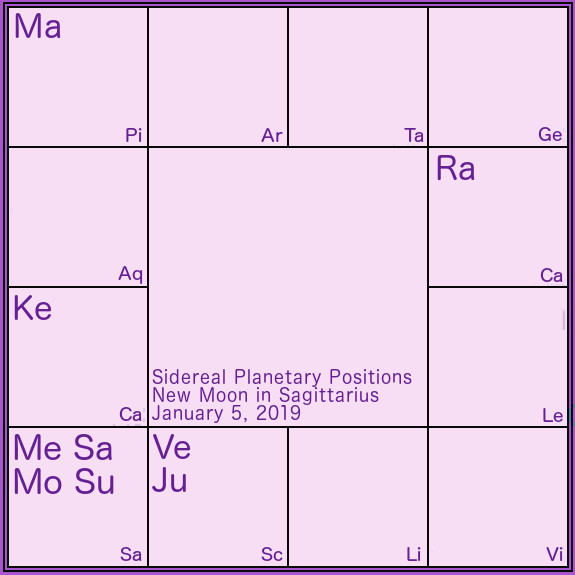
The Solar Eclipse
Though the eclipse may not be visible where you are, its effects are still tangible, and things are probably already gearing up with intensity in the area of your life indicated by Sagittarius. Though Rahu and Ketu are still in Cancer and Capricorn (since August of 2017), they are coming very close to transiting into Sagittarius and Gemini (which will happen in March), and this eclipse is giving us a taste of what is to come during the next nodal transit and the eclipses to occur in 2019 and 2020.
Forecast
Here are a few of the areas where challenges may be occurring due to this eclipse (and where you need to do the work), based on your Vedic rising sign (there can also be others, when examined specifically, or in a personal natal chart analysis):
Aries — education, faith, foreign travels
Taurus — sudden changes, upheaval, secrets coming to light
Gemini — partnerships, love, business relationships
Cancer — health issues, disputes, litigation, pets
Leo — children, wisdom, authority
Virgo — the heart, the mind, home, mother
Libra — siblings, will, skills
Scorpio — the family, wealth, the mouth
Sagittarius — self-identity, place in the world
Capricorn — loss, loneliness
Aquarius — community, friends, income
Pisces — career, social status
Please join me and my fellow astrologers on January 25th for the 2019 Jyotish Transit Summit Webinar. The webinar is free, and you can register through this link.

by Somya Devi | Dec 19, 2018 | Astrology, Conjunctions, Events, Retrograde
This coming full Moon night also falls on the longest night of the year in the northern hemisphere, the winter solstice! The solstice, December 21st, is the day when the Sun is at its farthest course south of the equator, making for the longest day in the southern hemisphere and the longest night in the northern. The Moon will be bright and waxing in its fullest Moon phase, purnima tithi, on this night, approaching maximum fullness in sidereal Gemini at 9:49 am PST on Saturday, December 22nd. Moon lovers, take this chance to enjoy the most moonlight you can get in one night, until this coincidence next occurs in 2094!
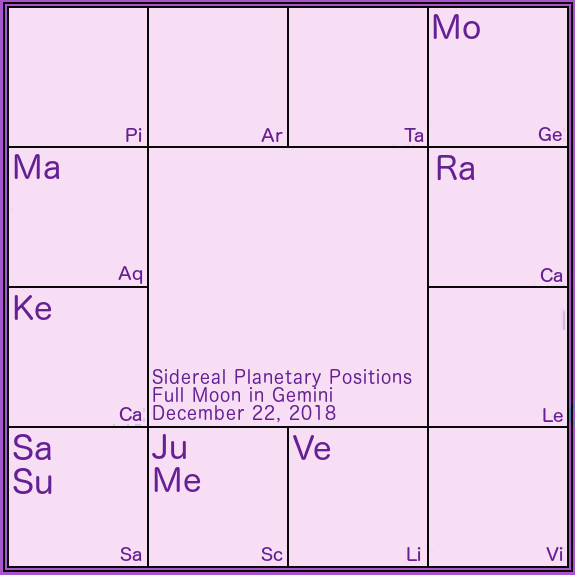
Full Moon in Gemini
The full Moon will reach maximum illumination at 6° sidereal Gemini, opposite the Sun at 6° sidereal Sagittarius. Also in Ardra nakshatra, this Full Moon is aligned with the outer reaches of our galaxy, stretching towards far distant space. This energy is appropriate for the winter solstice, which is a deeply yin time of year as we become more still in the lengthy hours of darkness, allowing more space in our beings, and in between our bouts of activity.
Ardra
Ardra, also Arudra, is a turbulent place, however, ruled by Lord Shiva in the form of Rudra, the fierce bringer of storms. Though there is a certain energy of renewal here, it is the type of renewal that comes after difficult or destructive situations. The full Moon here can help us to truly let go of some of the things from the past year that we no longer need, but for some it could be a chaotic-feeling process.
 Solstice
Solstice
The winter solstice is when the Sun is farthest from its northern course, allowing the night hours to exceed the day, the further you go north. It is also a turning point in the cycle of light, and after this point in time the light will slowly begin to return and the days lengthen. The solstice and the days surrounding are like a still point, however, like the powerful moment between exhalation and inhalation. Consider incorporating an awareness of this moment in the breath cycle into your meditation practice during this time of year.
It is somewhat paradoxical that we will experience the solstice and the full Moon together, as the winter solstice is a time to be very inward, and full Moon energy usually draws us out into a more extroverted state. Gemini is a dual sign that helps us to look at both sides of life, however, so it is also appropriate. With all things, there is a lesson coming forth to teach us about balance, and how to balance these energies, nourishing our inward nature while likely participating in some kind of gatherings or celebrations that draw our energy outward.
From the 22nd through the end of the year will be a waning phase for the Moon, and during this lunar cycle in particular, it is a potent time to allow yourself to let go of all the baggage from the past year, allowing it to compost and creating fertile ground for the next year to come (just as Shiva, the cosmic composter, brings this energy through the stormy rains).
Though the holidays are a time to celebrate, it’s important to be careful right now of overexerting your yang or active energy, and to recognize the real gift of cultivating yin during these dark months. It is a time to create more inward space for your body, mind and spirit. The dormant season of winter is a time to nourish and rejuvenate, and it’s important not to let these celebrations become depleting.
Jupiter-Mercury War
Jupiter and Mercury will be engaged in a planetary war (graha yuddha) from midday on December 20th through early morning on the 22nd. During this time the two planets will be traveling within one degree of each other, in sidereal Scorpio. This can bring up an internal conflict between what we strongly believe (philosophically, spiritually, or politically), and what makes sense in a practical, earthly way. This war can also create a paradox between two or more areas of your life, those ruled by Jupiter and Mercury in your individual natal chart. Check out your chart and pay attention to the interaction of what these planets rule for you over the next few days.
Venus
Venus is nearing the end of his four-month transit through sidereal Libra. Strong and powerful in his own sign, the ideals of beauty, pleasure and harmony have been forefront for many of us over the last few months. This transit began on August 31st, and Venus then appeared to slow to a halt and then travel in retrograde motion through Libra from October 5th through November 15th. This retrograde stint gave us a chance to really closely examine our relationships, as well as our approaches to happiness in general.
As we move forward through these last weeks of Venus in Libra, we should be integrating some of the lessons we have learned through this transit. What have the past few months taught you, and how can you proceed with more wholeness? What are your methods for seeking pleasure, and are these working for you? If not, what needs to change? When you get what you think you want, are you truly happy?
 Venus is the planet that reminds us that we aren’t usually truly happy if our pleasure comes at the expense of someone else’s whom we care about. How are you at compromising in your relationship? Is it too little, or too much, costing one of you (and thus both) the happiness you deserve? What kind of boundaries do you have with others in general, and are those working for you (or them)?
Venus is the planet that reminds us that we aren’t usually truly happy if our pleasure comes at the expense of someone else’s whom we care about. How are you at compromising in your relationship? Is it too little, or too much, costing one of you (and thus both) the happiness you deserve? What kind of boundaries do you have with others in general, and are those working for you (or them)?
This transit may also have gotten you in touch with the way you handle sensual indulgences, be it food, drink, shopping, sex, or intoxicants. The drive may have been turned on high during this period, with a chance to slow down and scrutinize your methods during the weeks of Venus Retrograde. Moving into the new year, as Venus transits into sidereal Scorpio on January 1st, take the opportunity to harvest and integrate the lessons you have learned about yourself, and your own Venusian nature.
2019
As we come into the New Year I will be adding more updates on what to expect, as well as co-hosting a Webinar on 2019 Transits with a number of my Jyotish colleagues. Be sure to tune into the webinar, stay on the free mailing list, and consider getting an individual reading to see how the coming year’s transits will affect you personally.
Many blessings and Happy Solstice!

 Nodes Are Changing Signs!
Nodes Are Changing Signs! The nodes, astronomically are the places where the Sun’s and Moon’s paths intersect. The ecliptic is the apparent paths that the Sun travels “around” the Earth. The Moon’s orbits is not completely flat or parallel with the Sun’s, but slightly inclined, so that it passes this line and is sometimes to the north of it, sometimes to the south. We can measure astronomically and by observation when these crossings happen. To get the mean node, we take an average distance between these two points based on how many days it takes the Moon to get from one to the other. The true node is calculated using a method that also accounts for the slight wobble of the earth and the Moon’s orbit around it.
The nodes, astronomically are the places where the Sun’s and Moon’s paths intersect. The ecliptic is the apparent paths that the Sun travels “around” the Earth. The Moon’s orbits is not completely flat or parallel with the Sun’s, but slightly inclined, so that it passes this line and is sometimes to the north of it, sometimes to the south. We can measure astronomically and by observation when these crossings happen. To get the mean node, we take an average distance between these two points based on how many days it takes the Moon to get from one to the other. The true node is calculated using a method that also accounts for the slight wobble of the earth and the Moon’s orbit around it.












